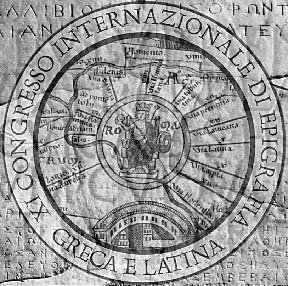

An impressive gathering of epigraphists assembled in the Teatro Quirino in Rome on 18 September for the opening session of the 11th International Congress of Greek and Latin Epigraphy.
A substantial volume of Preatti had been circulated in advance of the conference containing shorter contributions from more than 120 scholars. 41 longer papers, presented at the conference itself, offered surveys of recent progress and discoveries and a general perspective on the state of epigraphical studies in 1997. Alan Bowman and Roger Tomlin gave papers on recent work on the Vindolanda writing tablets and Romano-British curse tablets. Dr. Bowman's paper included a first public demonstration of the innovative work on image enhancement of stilus tablets being carried out jointly by the Centre and the Department of Engineering Science at Oxford (a preliminary report appeared in Newsletter no. 4).
New features of this Congress were a display of 25 posters in the foyer of the Teatro illustrating a range of epigraphical projects, and the presentation of contributions from each of the foreign schools in Rome. The latter included a comprehensive catalogue (Checklist) of Greek and Latin inscriptions in the U.S.A. compiled by John Bodel and Stephen Tracy for the American Academy in Rome and an electronic contribution from the British School at Rome: Roman Inscriptions of Tripolitania: a Photographic Repertory on CD-Rom. The CD-Rom, which offers an electronic version with digitised images of J.M. Reynolds and J.B.Ward-Perkins' original 1952 publication, is the result of a collaboration between Miss Reynolds and Prof. Michael Greenhalgh of the Australian National University. The database is also available on-line from ANU's Rubens WWW server.
As part of the programme of the Congress, visits were organised to the splendid new Epigraphic Department of the Museo Nazionale, to the opening of a major exhibition on Roman Spain (Hispania. From Conquered Territory to Province of the Empire) at which some of the more notable recent finds of bronze inscriptions, including the s.c. de Cn. Pisone patre, were on display; and to a new exhibition of Christian inscriptions in the Vatican Museum's epigraphical galleries. On the Sunday of the Congress there was an additional excursion to Ostia Antiqua in which more than 500 congressisti participated.
The Association International de l'Épigraphie Grecque et Latine (AIEGL) held its General Assembly on the second evening of the Congress at which a new committee was elected under the presidency of Prof. Werner Eck. Mrs. C.M. Roueché, Secretary of the British Epigraphy Society, was elected as vice President and Prof. Heikki Solin (University of Helsinki) as Secretary General. The venue for the 12th International Congress, to be held in 2002, was fixed as Barcelona.
The subject of IT and epigraphy was not addressed directly in the main proceedings of the Congress, but the AIEGL devoted part of its assembly to the question of how technological developments could best be exploited to advance epigraphical research. The number and diversity of current computer-based projects, so well reflected in the programme of the EDV Workshop held at the Austrian Institute after the Congress, were welcomed, but concern was expressed at the range of differing systems, font encodings and file formats used by the various projects. It was felt that the AIEGL should sponsor an initiative to ensure the widest possible access and compatibility across the whole range of available electronic resources. As a result of the discussion, a special commisssion (members: Prof. W. Eck (ex officio), Prof. S. Panciera, Prof. G. Alföldy, Dr. A. Bresson, Prof. K.S. Clinton, Dr. C.V. Crowther, Prof. M. Hainzman) was established to examine ways in which this aim could be met. Promoting interchangeability of data and transparency of access to different resources, as well as the avoidance of duplication of effort, were recognised as important elements of the commission's mandate which it is hoped can be completed in time for the Barcelona Congress.
Thanks to the efforts of its organising committee under the leadership of Prof. Panciera, the Rome Congress was a considerable success. The number of participants and the range of new work on which reports were presented testify to the continuing importance of epigraphical studies in renewing and revitalising our knowledge of the ancient world.
| Created on |